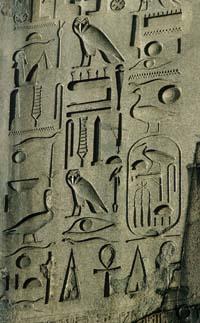Importance of position

It is a current phenomenon, but it cannot be thought that it was so at one time. Ancient civilizations, like each one had their own alphabet, also had their own numerical system. One can say more: first representations of writing numbers that emerged before civilizations invented their alphabets.
The most natural idea, to tell

It is to count the most basic and natural idea related to numbers. Surely 20,000 years ago, when a man then traced lines on an animal bone, he did them because something counted. This bone, known as Ishan bone, was found in Zaire and, according to an expert who has investigated it, the stripes performed orderly on the bone have to do with the cycles of the moon.
The Ishan bone is the oldest written support known and it would be no coincidence that the numbers written there had astronomical measurements. The development of mathematics is closely related to the development of astronomy, not only astronomy, but also administration, power and economics.
Because the Babylonians were skilled in astronomical measurements --a. C. Around 1600 - some indications of the numerical system have reached the present. This civilization, which arose on the banks of the Tigris and Euphrates rivers, developed a system of accounting in 60 bases, which today we use to measure angles, minutes and seconds. The use of the numbering system based on 60 is logical since being a number with a large number of dividers, the chances of divisions having a total result are high. Precise quotients were important for a civilization that did not use decimals. In addition, in the sky there are 12 constellations with great importance in astronomical measurements, the 12 and their multiples --60 for example-.
The man of Ishan would surely have to write so many stripes. Thus, the Babylonians devised a congestion system to write large numbers briefly. The first were written with scripts, but if ten were stacked, they replaced them with another symbol representing the dozen. Likewise, they were replaced by one of the sixty-six tenths.

Those mathematical knowledge was in the hands of priests and sages of the kingdom and not of anyone. In fact, they were largely state secrets. Once maths were dominated, architecture and geometry were dominated to build palaces, temples, altars of gods and walls. This knowledge was too important to remain in the hands of the enemy. Therefore, the teacher verbally transmitted to the student mathematical knowledge, so there are few written testimonies to analyze the mathematics of then.
The only mathematical texts that have been preserved since the Babylonian era were written in clay sheets. They wrote the procedure to solve a mathematical problem, with the clay still fresh and, once dry, the text was ready. This type of supports have faced the centuries, as well as the Egyptian hieroglyphs to the earth and the cold heat of the desert.

In Egyptian temples --a.C. Around 1800, when they wrote chronologies of pharaohs or any other account, they used the system of congestion, like the Babylonians, but with a change. They did not use base 60 but base 10. In short, the fingers of the hand are 10 and there can be the origin of the base. Ten units formed ten, and ten tenths—and not six, as in Babylon—the percentage. The system advanced upwards, with special symbols for one thousand and ten thousand, even for one hundred thousand and one million.
In addition to this system of accumulation, in Egypt they had another system. This system was called hieratic and was used by scribes to write on the papyrus. The hieratic had special symbols for digits one to nine, but also for multiples ten (10, 20, .., 90), multiples of tissues (100, 200, .., 900) and others. To write number 138, therefore, they successively placed three symbols: 100, 30 and 8. According to this, the scribes had only to write the number 40 with the only symbol and, therefore, they did not have in Egypt, not even in Babylon, a symbol of zero.
And zero is something very new in the history of numbers, related to another system. In Egypt and Babylon, congestion systems were used that forced the repetition of a symbol several times or, as in the case of the hieratic, a huge range of symbols were needed to make the system useful. Systems based on position and not repetition were created before these systems.
Position is important

In China, as in Egypt, they did not use the only numbering system. The first, the one used in the texts, had very worked symbols, such as those of the Chinese alphabet. To write the numbers they used the same mechanics with which they wrote the ideograms. The digits from one to nine were represented with an ideogram. They also had their own ideograms to express tenths of vegetables. Subsequently, these ideograms were combined to write the desired number. For example, to write number 74, ideograms 10 and 7 were combined, along with which 4 ideograms were written.
The second numbering system used in China was much simpler. On the one hand, there were fewer ideograms, on the one hand less the ninth, and on the other, their order was important. This system was used to make accounts on the blackboard, so it is evident the importance of order. When performing the sums, the operations were carried out by columns and, in some way, to facilitate writing, the ideograms corresponding to the tenths multiples were no longer necessary.

It can therefore be said that the evolution of numbering systems was marked by practical reasons. However, China did not use the zero number of special importance in the current system. In the slate calculations, if they had to write the number 104, they put 1 ideogram in the percentage column and 4 ideograms in the column of some. The column of the tithes therefore remained empty.
Zero, rich number
The invention of zero was fundamental, since it allowed to use a system of positions like the Chinese beyond the blackboards. But that invention was not made in China, but close in India --a. C. 500 -. What can be said about the Indian numbering system? Well, it is not worth getting into the explanations, since this numbering system is the precursor of the current one. The Indians had digits from one to nine and, for the first time in history, another symbol representing zero, like an O. In this way, they only used a position-based system, since zero filled the gap in which a certain multiple or reversing of ten did not appear.
Since the numbering system of the Indians had notable advantages over the rest of the systems of then, both for their simplicity and for their effectiveness, the rest of the civilizations were gradually taking over. The Arabs were the first to realize this and did a great work of transmission. As it is an expanding civilization, the Indian numbering system was brought to Europe and modified. Latin received the Arabic numerals in the Iberian Peninsula and in southern Italy, and from the Renaissance the rest of numerical expressions were discarded that were finally obsolete.






